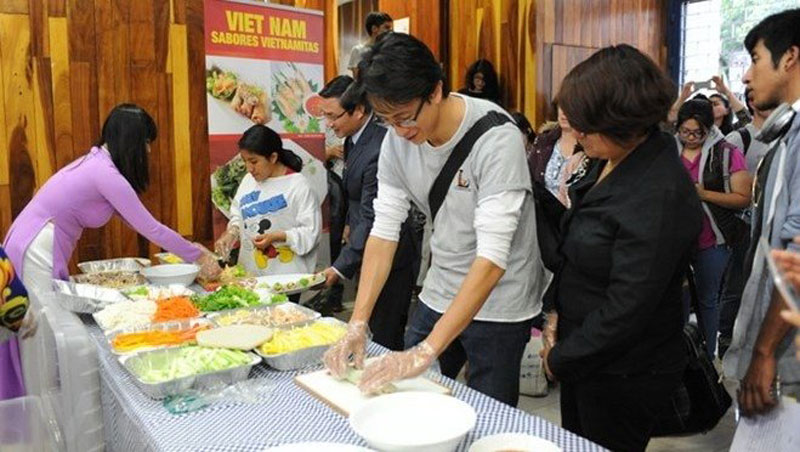
The National School of Languages, Linguistics and Translation under the National Autonomous University of Mexico (UNAM) and the Vietnamese Embassy in Mexico held a Day of Vietnamese Language and Cuisine and screened films to introduce Vietnamese culture to lecturers and students on October 5.

A student is making
Vietnamese spring rolls at the event.
At a Vietnamese-language class, First Secretary of the
Vietnamese Embassy in Mexico Lam Quoc Thanh presented an overview of the
origin, formation and development of the Vietnamese language.
Nearly 50 students learned Vietnam’s alphabet characters,
pronunciation and basic greetings. They expressed wish that more Vietnamese
classes will be opened.
Head of the Russian, Asian and contemporary Greek language
faculty Ricardo Cornejo said the school will consider adding Vietnamese
language into its curricula in the near future to meet students’ demand.
International and Mexican students were also introduced to
Vietnam’s rice paper – a specialty of the wet rice civilization. They learnt
how to make fresh spring rolls using rice papers.
On the occasion, they gained an insight into the unique culture of
H’Mong people, one of the 54 Vietnamese ethnic groups via the film "Story of
Pao” by director Ngo Quang Hai.
Source: NDO
Hoa Binh province has carried out multiple programmes and initiatives to revive its cultural heritage which has gradually fallen into oblivion through the ebbs and flows of history.
The most prominent and defining feature in the prehistoric era of Hoa Binh is the Hoa Binh Culture. The Culture was first discovered in Hoa Binh. The significant prehistoric culture represents not only Vietnam but also Southeast Asia and southern China. Through excavations of cave sites in the limestone regions of Hoa Binh, French archaeologist M. Colani introduced the world to a "Stone Age in Hoa Binh province – Northern Vietnam" in 1927. On January 30, 1932, the First Congress of Far Eastern Prehistorians, held in Hanoi, officially recognised the Hoa Binh Culture.
Known as the "Land of Epic History”, Hoa Binh province, the gateway to Vietnam’s northwest, boasts a strategic location and a unique cultural tapestry woven by its ethnic minority communities.
The People's Committee of Luong Son District recently held a ceremony to receive the certificate recognizing Sau Communal House in Thanh Cao Commune as a provincial-level historical and cultural site.
Recognising the importance of cultural heritage preservation in protecting and promoting the value system of Vietnamese culture, and serving socio-economic development in the new period, Party committees and local administrations in Hoa Binh province have identified it as a key task in the cultural development strategy. The province has been making efforts in mobilising resources, creating consensus among people and engaging ethnic communities in preserving and promoting cultural identity.
Hoa Binh province has captured growing attention both domestically and internationally for its distinctive cultural heritage and rich history. Most notably, it has been renowned for its famous Hoa Binh culture, considered the cradle of ancient Vietnamese civilisation. Looking ahead to significant milestones in 2025 and the 140th anniversary of province establishment in 2026, Hoa Binh Newspaper presents a comprehensive overview of the province's development across economic, social, cultural, tourism, and security domains.



